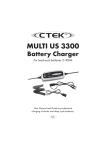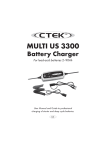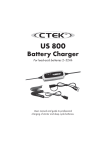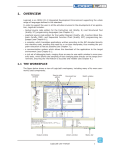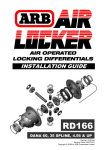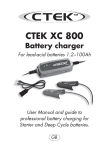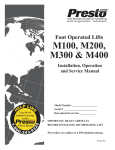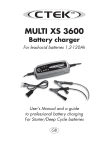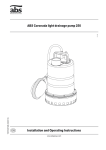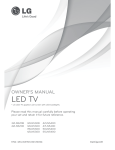Download CTEK 1018 User manual
Transcript
MULTI US 7002 Battery Charger For lead-acid batteries 14–150Ah User Manual and Guide to professional charging of starter and deep cycle batteries. Model 1018 US INTRODUCTION The MULTI US 7002 is a primary switch mode battery charger with pulse maintenance. The MULTI US 7002 is designed to offer maximum life for the battery. MULTI US 7002 is a member of a family of professional chargers from CTEK Power Inc. It represents the state-of-the-art of today’s technology for battery charging. Please read these operating instructions carefully before operating the MULTI US 7002. IMPORTANT SAFETY INSTRUCTIONS California Proposition 65 WARNING: This product contains chemical known to the state of California to cause cancer or reproductive toxicity. 1. SAVE THESE INSTRUCTIONS – This manual contains 2. 3. 4. 5. 6. 7. 8. 9. 10. important safety and operating instructions for battery charger models 1018. When charging, batteries can emit explosive gases, therefore it is essential to preYHQWÀDPHVDQGVSDUNV7KHFKDUJHULVGHVLJQHGIRUFKDUJLQJOHDGDFLGEDWWHULHV from 14 to 150Ah. Do not use for any other purpose. Do not expose to rain or snow. Always provide good ventilation when charging. Use of an attachment not recommended or sold by the battery charger manufacWXUHUPD\UHVXOWLQDULVNRI¿UHHOHFWULFVKRFNRULQMXU\WRSHUVRQV To reduce risk of damage to electric plug and cord, pull by the plug rather than cord when disconnecting charger. An extension cord should not be used unless absolutely necessary. Use of imSURSHUH[WHQVLRQFRUGFRXOGUHVXOWLQDULVNRI¿UHDQGHOHFWULFVKRFN,IDQH[WHQsion cord must be used, make sure that: a) Pins on plug of extension cord are the same number, size and shape as those of plug on charger; b) Extension cord is properly wired and in good electrical condition; and c) Wire size is large enough for DFDPSHUHUDWLQJRIFKDUJHUDVVSHFL¿HGLQ³WHFKQLFDOGDWD´ Do not operate charger with damaged cord or plug – return the charger to the place where purchased. Never operate the charger if it has received a sharp blow, been dropped or otherZLVHGDPDJHGLQDQ\ZD\WDNHLWWRDTXDOL¿HGVHUYLFHPDQ 'RQRWGLVDVVHPEOHFKDUJHUWDNHLWWRDTXDOL¿HGVHUYLFHPDQZKHQVHUYLFHRUUHSDLULVUHTXLUHG,QFRUUHFWUHDVVHPEO\PD\UHVXOWLQDULVNRIHOHFWULFDOVKRFNRU¿UH To reduce risk of electric shock, unplug charger from AC outlet before attempting any maintenance or cleaning. Turning off controls will not reduce the risk. 2 • US 11. WARNING - RISK OF EXPLOSIVE GASES a) WORKING IN VICINITY OF A LEAD-ACID BATTERY IS DANGEROUS. BATTERIES GENERATE EXPLOSIVE GASES DURING NORMAL BATTERY OPERATION. FOR THIS REASON, IT IS OF UTMOST IMPORTANCE THAT, YOU FOLLOW THE INSTRUCTIONS EACH TIME YOU USE THE CHARGER. b) To reduce risk of battery explosion, follow these instructions and those published by the battery manufacturer and the manufacturer of any equipment you intend to use in vicinity of battery. Review cautionary marking on these products and on engine. 12. PERSONAL PRECAUTIONS a) Consider have some one close enough by to come to your aid when you work near a lead-acid battery. b) Have plenty of fresh water and soap nearby in case battery acid contacts skin, clothing or eyes. c) Wear complete eye protection and clothing protection. Avoid touching eyes while working near battery. d) If battery acid contacts skin or clothing, wash immediately with soap and water. ,IDFLGHQWHUVH\HLPPHGLDWHO\ÀRRGH\HZLWKUXQQLQJFROGZDWHUIRUDWOHDVW minutes and get medical attention immediately. e) 1(9(5VPRNHRUDOORZDVSDUNRUÀDPHLQYLFLQLW\RIEDWWHU\RUHQJLQH f) Be extra cautious to reduce risk of dropping a metal tool onto battery. It might spark or short-circuit battery or other electrical part that may cause explosion. g) Remove personal metal items such as rings, bracelets, necklaces, and watches when working with lead-acid battery. A lead-acid battery can produce a short-circuit current high enough to weld a ring or the like to metal, causing a severe burn. h) Use charger for charging a LEAD-ACID battery only. It is not intended to supply power to a low voltage electrical system other than in a starter-motor application. Do not use battery charger for charging dry-cell batteries that are commonly used ZLWKKRPHDSSOLDQFHV7KHVHEDWWHULHVPD\EXUVWDQGFDXVHLQMXU\WRSHUVRQVDQG damage to property. i) Never charge a frozen battery. US • 3 13. PREPARING TO CHARGE a) If necessary to remove battery from vehicle to charge, always remove grounded WHUPLQDOIURPEDWWHU\¿UVW0DNHVXUHDOODFFHVVRULHVLQWKHYHKLFOHDUHRIIVRDV not to cause an arc. b) Be sure area around battery is well ventilated while battery is being charged. c) Clean battery terminals. Be careful to keep corrosion from coming in contact with eyes. d) $GGGLVWLOOHGZDWHULQHDFKFHOOXQWLOEDWWHU\DFLGUHDFKHVOHYHOVSHFL¿HGE\EDWWHU\PDQXIDFWXUHU'RQRWRYHU¿OO)RUDEDWWHU\ZLWKRXWUHPRYDEOHFHOOFDSVVXFK as valve regulated lead acid batteries, carefully follow manufacturer’s recharging instruction. e) 6WXG\DOOEDWWHU\PDQXIDFWXUHU¶VVSHFL¿FSUHFDXWLRQVZKLOHFKDUJLQJDQGUHFRPmended rates of charge. f) Determine voltage of battery by referring to car owner’s manual and make sure that WKHRXWSXWYROWDJHVHOHFWRUVZLWFKLVVHWDWFRUUHFWYROWDJH,IFKDUJHUKDVDGMXVWDEOH charge rate, charge battery initially at lowest rate. 14. CHARGER LOCATION a) Locate charger as far away from battery as DC cables permit. b) Never place charger directly above battery being charged; gases from battery will corrode and damage charger. c) 1HYHUDOORZEDWWHU\DFLGWRGULSRQFKDUJHUZKHQUHDGLQJHOHFWURO\WHVSHFL¿FJUDYLW\ RU¿OOLQJEDWWHU\ d) Do not operate charger in a closed-in area or restrict ventilation in any way. e) Do not set a battery on top of charger. 15. DC CONNECTION PRECAUTIONS a) Connect and disconnect dc output clips only after setting any charger switches to ³RII´SRVLWLRQDQGUHPRYLQJDFFRUGIURPHOHFWULFRXWOHW1HYHUDOORZFOLSVWRWRXFK each other. b) Attach clips to battery and chassis as indicated in 16(e), 16(f), 17(b) through 17(d). 16. FOLLOW THESE STEPS WHEN BATTERY IS INSTALLED IN VEHICLE. A SPARK NEAR BATTERY MAY CAUSE BATTERY EXPLOSION. TO REDUCE RISK OF A SPARK NEAR BATTERY: 4 • US a) Position AC and DC cords to reduce risk of damage by hood, door or moving engine part. b) 6WD\FOHDURIIDQEODGHVEHOWVSXOOH\VDQGRWKHUSDUWVWKDWFDQFDXVHLQMXU\WR persons. c) Check polarity of battery posts. POSITIVE (POS, P, +) battery post usually has larger diameter than NEGATIVE (NEG, N, -) post. d) Determine which post of battery is grounded (connected) to the chassis. If negative post is grounded to the chassis (as in most vehicles) see (e). If positive post is grounded to the chassis, see (f). e) For Negative-grounded vehicle, connect POSITIVE (RED) clip from battery charger to POSITIVE (POS, P, +) ungrounded post of battery. Connect NEGATIVE (BLACK) clip to vehicle chassis or engine block away from battery. Do not connect clip to carburetor, fuel lines, or sheet-metal body parts. Connect to a heavy gage metal part of the frame or engine block. Charger connection. 1. Connect positive charger clip (red) to positive battery terminal. 2. Connect negative charger clip (black) to a good metal engine ground away from the battery. Do no connect clip to fuel lines or sheet-metal body parts. 3. Connect the AC cord to the socket. The red alarm indication light will indicate a battery which is connected to reverse polarity. f) For Positive grounded vehicle, connect NEGATIVE (BLACK) clip from battery charger to NEGATIVE (NEG, N, –) ungrounded post of battery. Connect POSITIVE (RED) clip to vehicle chassis or engine block away from battery. Do not connect clip to carburetor, fuel lines, or sheet-metal body parts. Connect to a heavy gage metal part of the frame or engine block. Charger connection. 1. Connect negative charger clip (black) to negative battery terminal. 2. Connect positive charger clip (red) to a good metal engine ground away from the battery. Do no connect clip to fuel lines or sheet-metal body parts. 3. Connect the AC cord to the socket. The red alarm indication light will indicate a battery which is connected to reverse polarity. g) When disconnecting charger, turn switches to off, disconnect AC cord, remove clip from vehicle chassis, and then remove clip from battery terminal. h) See operating instructions for length of charge information. US • 5 17. FOLLOW THESE STEPS WHEN BATTERY IS OUTSIDE VEHICLE. A SPARK NEAR BATTERY MAY CAUSE BATTERY EXPLOSION. TO REDUCE RISK OF A SPARK NEAR BATTERY: a) Check polarity of battery terminals. POSITIVE (POS, P, +) battery post usually has a larger diameter than NEGATIVE (NEG, N, -) post. b) Attach at least a 24-inch-long 6-gauge (AWG) insulated battery cable to NEGATIVE (NEG, N, -) battery post. c) Connect POSITIVE (RED) charger clip to POSITIVE (POS, P, +) battery of post. d) Position yourself and free end of cable as far away from battery as possible – then connect NEGATIVE (BLACK) charger clip to free end of cable. e) 'RQRWIDFHWKHEDWWHU\ZKHQPDNLQJWKH¿QDOFRQQHFWLRQ f) When disconnecting charger, always do so in reverse sequence of connecting SURFHGXUHDQGEUHDN¿UVWFRQQHFWLRQZKLOHDVIDUDZD\IURPEDWWHU\DVSUDFWLFDO g) When disconnecting charger, disconnect in reverse sequence from connecting procedure. See operating instructions for charge information. h) A marine (boat) battery must be removed and charged on shore. To charge it on board requires equipment specially designed for marine use. The battery charger must be connected to the battery according to the instructions above. IMPORTANT SAFETY INFORMATION! The MULTI US 7002 cannot be used to restore a fully worn out battery. If the MULTI US 7002 does not switch to maintenance charge after three days (green light illuminated), there is a fault. Possible causes: • The battery is probably worn out and should be replaced. • Some large antimony batteries may behave different and can allow the MULTI US 7002 to charge the battery for too long, which can lead to overcharging. See caution! • ,IKHDY\SRZHUFRQVXPHUVOLNH¿WWHGDODUPVDQGQDYLJDWLRQFRPSXWHUVDUHFRQQHFWHGWR the battery, the charging process takes longer and this can also overcharge the battery. • $VXOSKDWHGEDWWHU\ZLOORQO\DFFHSWFXUUHQWZLWKGLI¿FXOW\DQGFRQVHTXHQWO\WKHFKDUJing process takes a particularly long time. A worn out battery cannot be fully charged. Therefore you should always check whether the charger has been switched to maintenance charge before you leave it turned on or unobserved for any length of time. 6 • US Caution: If the MULTI US 7002 does not switch to maintenance charge mode after three days, manually switch it to pulse maintenance mode. Note: A battery that hasn’t changed to maintenance charge after three days is most likely worn out and needs to be replaced. All other batteries can be maintained for a very long time. BATTERY TYPES AND SETTINGS MULTI US 7002 can easily be set for different types of batteries or conditions. The following recommendations should, however, only be seen as guidelines. Please consult the battery manufacturer for further instructions. 6HWWLQJVDUHPDGHE\SUHVVLQJWKH´02'(EXWWRQ´DQGVWHSSLQJIRUZDUGRQHSUHVVDWD time until the required mode is reached, the button is then released. After about 2 seconds the charger activates the selected mode. The selected mode is saved in a memory in the charger and remains there even if the charger is switched off. Mode 14.4V - Normal setting for wet batteries, maintenance free and for NORMAL most Gel batteries. Some Gel batteries prefer a slightly lower charging voltage. Please consult the battery manufacturer when in doubt. Mode 14.7V - This setting is recommended for a battery at temperatures < 41°F. It is also recommended for many AGM batteries like Optima, and Odysseys. Consult your battery manufacturer when in doubt. Mode 13.6V / Supply - The charger is operating at a constant voltage of SUPPLY 13.6V. This is the maintenance mode for applications where maximum caSDFLW\IURPWKHEDWWHU\LVLPSRUWDQWOLNHÀRRUVZHHSHUVDQGJROIFDUWV1RWH that the Spark protection function is suppressed in this mode. Mode 15.7V / 1.5A / 0.5–4h - This mode is used to recover deep discharged ÀRRGHGEDWWHULHVZKHUH\RXFRXOGH[SHFWDVWUDWL¿HGDFLGKLJKDFLGZHLJKW in the bottom, low on top). This mode will also recover some spiral cell AGM batteries that has been deep cycled. Check with battery manufacturer when in doubt. RECOND 1RWHWKDWWKHEDWWHU\KDVWREHIXOO\FKDUJHG¿UVW8VHWKLVPRGHZLWKFDUH because the high voltage will cause some water loss. 16V is normally no problem for electronics, but consult your supplier when in doubt. Life of light bulbs will be reduced at higher voltage. Try to avoid using 12V light from the battery during this phase. Maximum effect and minimum risk for electronics is achieved by charging a disconnected battery. US • 7 CHARGING The battery charger must be connected to the battery according to the instructions above. Start charging 1. Connect the power cord to the power outlet. 2. Set the proper charging mode for the battery by pushing the Mode button until the FRUUHFWVHWWLQJLVOLW&KRRVLQJVHWWLQJVIRU\RXUEDWWHU\LVGHVFULEHGXQGHU´%$77(5< 7<3(6$1'6(77,1*6´ 3. The lamp for Deep Discharged battery (1) will indicate if the battery voltage is low. If lamp 1 blinks, this indicates that the battery is lightly sulphated. Read more under ´&+$5*,1*3+$6(6´ 4. Normal charging is indicated by the following lamps: Deep Discharged (1), Bulk Charge (2), Absorption Charge (3) or Maintenance Charging (4). When the maintenance lamp is lit, the battery is fully charged. The charge will restart if the voltage drops. The charger can be connected for months. SUPPLY or RECOND are indicated when the lamps for these settings are lit (5 or 6). 5. If the battery cables are connected incorrectly, the reverse polarity protection will make sure that neither the charger nor the battery are damaged. In this case, the red warning lamp (0) will be lit. 6. If nothing happens. If the setting lamp is lit but no other light comes on, the connection to the battery or to the chassis may be poor, or the battery may be faulty. Start by improving the contact between the battery and the charger. 7. Charging can be interrupted at any time by disconnecting the power cord from the wall socket or by putting the charger in "Standby" mode (lamp A). Always disconnect the power cord from the socket before removing the battery cables. When you interrupt charging of a battery mounted in a vehicle, always disconnect the battery cable from the chassis before removing the other battery cable. 8 • US Current CHARGING PHASES Soft Start Bulk Absorption Analysis Recond Float Pulse Voltage Desulphation Mode chosen: ”NORMAL” or ”SNOWFLAKE” MULTI US 7002 is a multi stage fully automatic charger. Lamp B for chosen setting ´1250$/´DQGODPS&IRUFKRVHQVHWWLQJ´612:)/$.(´ Desulphation (Lamp 1, blinking) Desulphation with pulsing for sulphated batteries. Indicated by blinking lamp 1. Start (Lamp 1) Starting phase for charging. The starting phase continues until the battery’s terminal voltage has risen over a preset level. At this point, charging goes into the bulk phase. If the terminal voltage has not reached the preset level within 8 hours, charging is suspended. The error mode is indicated. This indicates a battery which is faulty or has too large capacity. If a large battery is charged that has been severely discharged, it may be necessary to restart the charger after 8 hours. Start is indicated by lamp 1. Bulk (Lamp 2) Primary charging where approximately 80% of the charging happens. The charger delivers maximum voltage until the terminal voltage has risen to the preset level. After a number of hours, the charger goes on to the next phase, even if maximum voltage is not reached. Bulk is indicated by lamp 2. US • 9 Absorption (Lamp 3) Final charging, voltage is kept at the preset level. During this phase, the voltage is gradually reduced. If the maximum length of time for Absorption is exceeded, the charger automatically continues with Analysis. Absorption is indicated by lamp 3. Analysis (Lamp 3) Charging is suspended for a short period and the battery voltage measured. If it falls too quickly, the battery is probably faulty. Charging is suspended and an error is indicated (lamp 0). 0DLQWHQDQFHFKDUJLQJÁRDW/DPS 'XULQJWKH¿UVWGD\VRIPDLQWHQDQFHFKDUJLQJWKHEDWWHU\LVPDLQWDLQHGZLWKFRQVWDQW voltage, 13.6V. Float-maintenance is indicated by lamp 4. Maintenance charging - pulse (Lamp 4) The state of charge varies between 95% and 100%. The battery receives a pulse when the voltage sinks, keeping the battery in good shape when it is not being used. The charger can be connected for months at a time. If the battery is charged and/or the battery’s terminal voltage drops, the charger starts a charge pulse until the voltage has reached the preset level, 14.4V or 14.7V. The charge pulse is then interrupted and the cycle is repeated as long as the charger is in pulse maintenance phase. If the terminal voltage drops even lower, the charger automatically reverts to the beginning of the charging curve. Pulse maintenance phase is indicated by lamp 4. If possible, check the water level in the battery. Chosen mode: ”SUPPLY” MULTI US 7002 has a Supply mode setting which has a constant voltage of 13.6V and current up to 7A. This mode can also be used for maintenance charging of an already fully charged battery, called Float maintenance. This type of charging keeps the battery at 100% charge. The constant small overcharge can also increase water loss. A battery does not have to be connected for the charger to deliver voltage. This means that the spark protection is not active in this mode. It is not appropriate to charge a completely discharged battery in Supply mode, since this will not result in a completely charged battery. In this mode, MULTI US 7002 can also be used as a power generation unit for operating equipment that requires 13.6V and a maximum of 7A. If the selected current exceeds 7A, the output voltage will drop as the load increases. The charger has electronic overload protection in this mode, which is activated if the charge is so great that the output voltage from the charger falls below around 9V and the current ís around 7A. In the event of an overload, the charger goes into error mode (lamp 0). Supply mode is indicated with lamp D and lamp 5. 10 • US Chosen mode: ”RECOND” MULTI US 7002 has a Recond mode which is used to recondition a battery that has been VHYHUHO\GLVFKDUJHG7KHEDWWHU\LV¿UVWFKDUJHGXVLQJWKHPRGH´1250$/´:KHQWKH analysis phase is complete, the charger begins reconditioning the battery by providing a constant current of 1.5A and a maximum voltage of 15.7V. After 0.5–4 hours, the battery is completely reconditioned and the charger goes into pulse maintenance. The battery is ready to be used, or store it with pulse maintenance active until you are ready to use the battery. Recond is indicated by lamp E and lamp 6. Note that the recond phase begins with normal charging and that the charger therefore will indicate the charging phases acFRUGLQJWRWKHGHVFULSWLRQVDERYH¿UVW/DPSLV¿UVWOLWZKHQWKHUHFRQGLWLRQLQJEHJLQs. INDICATORS 3 2 1 0 4 5 SUPPLY 6 RECOND MODE A B NORMAL C D E SUPPLY RECOND Indication Description 0 1 2 3 4 5 6 Error mode, the charger suspends the charging / voltage maintenance. See further description below. Start mode. Bulk charging, maximum voltage. Absorption charging, voltage limited to chosen voltage. Pulse maintenance charging 6XSSO\PRGH¿[HGRXWSXWYROWDJHQRFRXQWHUYROWDJHUHTXLUHPHQW Recond charging A B C D E STANDBY 0RGH´1250$/´9 0RGH´612:)/$.(´9 0RGH´6833/<´9 0RGH´5(&21'´9$±K US • 11 Error mode The charger enters error mode before start in the following situations: • The battery is connected with poles reversed to the charger's terminals. • The terminals on the charger are short-circuited. Error mode before start is reset by removing the error situation. The charger restarts in the latest selected mode. The charger enters steady error mode in the following situations: • The charger’s analysis function has interrupted charging. • The charger is overloaded in Supply mode. • The charger has been in start mode longer than maximum time. 6WHDG\HUURUPRGHLVDFNQRZOHGJHGUHVHWE\SUHVVLQJWKH´02'(´EXWWRQ7KHFKDUJHU restarts in the latest selected mode. BULK CHARGING TIME 12 • US Battery size (Ah) Time to ~80% charge (h) 14 50 90 150 2 6–7 11–13 20–22 TECHNICAL DATA Model Voltage AC 1018 100–115VAC, 50–60Hz. Output power is reduced at lower input voltage. Current 2.0A rms Back Current Drain* < 3mA Charging Voltage Nominal: 12V or 15.7V Ripple** Max 150mV rms, max 0.3A Charging Current 7A max Battery cable fuse 15A Ambient Temperature -4°F to +122°F. Automatic reduction of power at increased ambient temperature. Cooling Natural convection. Do not cover the charger. Charge cycle MULTI US 7002 is a multistage fully automatic charger. Type of batteries All types of lead-acid batteries (Wet, Maintenance Free, AGM and most GEL). Battery Capacity 14–150Ah Dimensions 81/2 x 31/2 x 17/8 inches (L x W x H) Insulation Raintight. Weight 1.7 lbs *) Back Current Drain is what the charger uses to drain the battery if the power cord is disconnected. The reverse current of the MULTI US 7002 is very low and corresponds to 1Ah per month. **) The ripple wave describes how many disturbances are exhibited by current and voltage. A rippled voltage can cause damage to other equipment connected to the battery. The MULTI US 7002 supplies voltage and current with very low voltage rippling. This increases the life of the battery and ensures that equipment connected to it will not be damaged. Recommended Minimum AWG Size for AC Extension cords Length of cord feet (m) AWG Size of cord 25 (7.6) 50 (15.2) 100 (30.5) 150 (45.6) 18 18 18 16 US • 13 OVERHEATING PROTECTION The MULTI US 7002 is equipped with overheating protection. In high ambient temperatures the output power is reduced. Do not cover the charger. BATTERY CABLES MULTI US 7002 is equipped with a set of battery cables with battery terminal clips and one set of battery cables with eyelet terminals. Do not shorten the battery cables. Connecting the provided cables with eyelet terminals Make sure that the cable is not pinched or in contact with warm surfaces or sharp edges. When the cable is mounted on the battery, it should not be connected to the charger. Connect the eyelet terminals to the battery's poles - the red cable to the positive pole and the black cable to the negative pole. After this, the quick connector can be connected. MAINTENANCE The MULTI US 7002 is maintenance-free. The charger must not be opened; doing so will invalidate the warranty. If the power cable is damaged it must be replaced by CTEK or its authorized representative. The charger casing can be cleaned using a damp cloth and mild cleaning agent. Remove the plug from the power socket before cleaning. LIMITED WARRANTY CTEK Power Inc, 2374 Edison Blvd, Twinsburg, OH 44087-2376, USA issues this limited warranty to the original purchaser of this product. This limited warranty is not transferable. CTEK Power Inc warrants this unit for 5 years from the date of purchase against defect workmanship or material. It is the obligation of the purchaser to forward the unit together with proof of purchase to the manufacturer or its representative with transportation cost prepaid. This warranty is void if the unit is abused, handled carelessly or repaired by anyone other than CTEK Power Inc or its authorized representative. CTEK Power Inc makes no warranty other than this limited warranty and expressly excludes any implied warranty including any warranty for consequential damages. This is the only expressed limited warranty and CTEK Power Inc neither assumes nor authorizes anyone to assume or make any other obligation towards the product other than this limited warranty. CTEK Power Inc. 2374 Edison Blvd Twinsburg, OH 44087-2376 USA Fax: + 1 330 963 0982 www.ctek.com 14 • US














